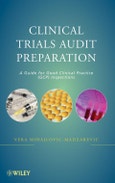The Good Clinical Practice (GCP) audit is a tedious but necessary exercise that assures that all parties do their job properly and in compliance with the applicable FDA code. Clinical Trials Audit Preparation demystifies the audit process for all parties involved, including clinical research sponsors, clinical investigators, and institutional review boards.
This book provides a step-by-step explanation of the FDA audit procedures for clinical trials and of how pharmaceutical companies, clinical investigators, and institutional review boards should prepare for regulatory audits. The book emphasizes the processes and procedures that should be implemented before a clinical audit occurs, making this an imperative guide to any professional in the drug manufacturing industry, including drug manufacturing companies, regulatory affairs personnel, clinical investigators, and quality assurance professionals.
Among the topics discussed:
-
Good Clinical Practices and therapeutic product development in clinical research
-
The roles of the sponsor of a clinical investigation, the IRB, or independent ethics committee
-
The roles and responsibilities of the clinical trial investigator
-
The inspection preparation
-
The Audit Report and the Form 483
-
Warning letters issued to clinical investigators and clinical trial sponsors and their impact on product development
Table of Contents
Preface.Introduction: Background History on Clinical Standards.
Glossary.
Chapter 1. Good Clinical Practice and Therapeutic Product Development.
1.1 Good Clinical Practice in Clinical Research.
1.2 Role of the Sponsor of a Clinical Investigation.
1.3 Role of the Institutional Review Board/Independent Ethics Committee (IRB/IEC).
1.4 Roles and Responsibilities of the Clinical Trail Investigator.
1.5 Clinical Trial Protocol and Protocol Amendments.
Chapter 2. Therapeutic Products Clinical Development in the United States.
2.1 Drug Discovery.
2.2 Preclinical Development.
2.3 Clinical Development.
2.4 FDA Considerations for Drug Development.
2.5 Phase IV, Postmarketing Surveillance and GCP.
2.6 Quality Assurance in Clinical Research.
2.7 FDA Inspectional Background and Data.
2.8 DFA Bioresearch Monitoring Program.
Chapter 3. The Inspection Preparation.
3.1 Conduct of an Internal GCP Inspection: Quality Assurance Inspection.
3.2 Steps to Prepare for the Internal QA Inspection.
3.3 The GCP Quality Assurance Unit.
3.4 Steps to Prepare for the Regulatory Inspection.
3.5 Clinical Investigator Inspections Preparation.
3.6 What to Do When an Investigator Site FDA Inspection is Announced.
3.7 Sponsor’s Inspection Preparation.
3.8 What to Do When Sponsors FDA Inspector Arrive Unannounced.
3.9 The Institutional Review Board Inspections Preparation.
3.10 What to Do When an IRB FDA Inspection is Announced.
3.11 The Investigator Site Inspection.
3.12 Investigator’s Responsibilities.
3.13 Types of Clinical Investigator Site Inspections.
3.14 Inspectional Procedures.
3.15 FDA Audit Procedures for Investigative Sites.
3.16 FDA Inspections of International Clinical Trial Sites.
3.17 The Audit Report and Form.
Chapter 4. Analysis of Warning Letters.
4.1 Analysis of Warning Letters Issued to Clinical Investigators.
4.2 An Analysis of Warning Letters Issued to Clinical Trial Sponsors.
4.3 Analysis of Warning Letters Issued to Institutional Review Boards.
Chapter 5. Fraud and Misconduct in Clinical Research.
5.1 What Type of Data is Falsified?
5.2 How is Data Falsified?
5.3 Why is Data Falsified?
5.4 Who Falsified the Data?
5.5 What Can be Done to Detect Fraud?
5.6 How Do We Prevent Fraud?
Appendix A. Some Answers to the Most Problematic Questions in Compliance.
Appendix B. Guidance for Industry - E6 Good Clinical Practice: Consolidated Guidance.
Appendix C. World Medical Association Declaration of Helsinki Ethical Principles for Medical Research Involving Human Subjects.
Appendix D. Nuremberg Code.
Appendix E. The Belmont Report: Ethical Principles and Guidelines for the Protection of Human Subjects of Research.
Index.








